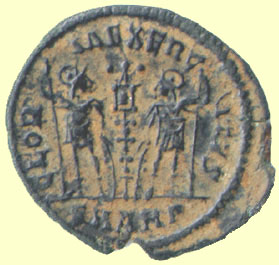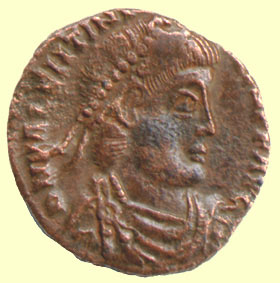 Contents -
Previous Article -
Next Article
Contents -
Previous Article -
Next Article
The Author's First Mailorder Ancient Coin Purchase
The reader's first experience with a mail order coin purchase will likely be similar to that of a friend of the author's, which is quoted here.
I decided to take a chance. I responded to the ad in CoinAge for "Roman Coins By Emperor: $6.95 each or eight for $48.00." The package arrived about two weeks later, delivered by a guy in a brown truck with gold lettering on the side. I wondered what kind of 1600 year old coins I could get for less than $7.00 each. At that price, how could I be sure that they are not fakes? As I opened that mailer, I was greeted by a truly unusual sight. Most of the coins were a dark brown to black and ranged from slightly larger in diameter than a U.S. one cent piece to quite a bit smaller than a dime (21 down to 13 mm). I was lucky and found one or two pieces that were a smooth Hershey's Milk Chocolate brown and had some pretty decent detail. In later orders, I would sometimes receive a coin that is virtually uncirculated, but with a chunk out of the flan or a patch of corrosion somewhere on its surface. I received a small bronze of Valentinian I on my first order that was as sharp as the day it was struck, but had about 15% of the flan missing. I am still amazed at my good fortune in getting that piece. As I sit proofreading and editing this article for the Web and multimedia, I can look back and say that a couple of my favorite coins even today came in that first batch from Michael Marx so many years ago.
 A similar experience awaits you if you have never before purchased ancient coins by mail or wandered into a dealer's shop to spend a few pleasant hours browsing his or her "junk box." You might find some pieces with a dark to light green patina (very desirable if not crusty) or a not so desirable white, tan, or light brown patina. At first, the legends might appear to be unreadable, but after time you will begin to be able to read those letters with the strange wedge-shaped vertical strokes, exaggerated loops, and oversize serifs. In fact, you will eventually be able to rely on the peculiarities of the lettering as an indication that the coin is genuine should you start to acquire some of the rarer pieces. But for now, you should not have any qualms about the authenticity of inexpensive late Roman Bronze in Fine to VF. There are many millions of these coins that have survived out of mintages into the hundreds of millions. The large-lot price of these coins will be about $1 - $3 all day long and not really worth the effort to counterfeit. (although some crude and sloppy "souvenirs" do exist!) Though this assertion that these coins were minted in the hundreds of millions may seem exaggerated to many who believe the ancients were technologically backwards, I will show in another article how they could and did mint such quantities of coins. The manufacturing and metallurgical technology of the Romans was quite sophisticated compared even to that of 1200 years later.
A similar experience awaits you if you have never before purchased ancient coins by mail or wandered into a dealer's shop to spend a few pleasant hours browsing his or her "junk box." You might find some pieces with a dark to light green patina (very desirable if not crusty) or a not so desirable white, tan, or light brown patina. At first, the legends might appear to be unreadable, but after time you will begin to be able to read those letters with the strange wedge-shaped vertical strokes, exaggerated loops, and oversize serifs. In fact, you will eventually be able to rely on the peculiarities of the lettering as an indication that the coin is genuine should you start to acquire some of the rarer pieces. But for now, you should not have any qualms about the authenticity of inexpensive late Roman Bronze in Fine to VF. There are many millions of these coins that have survived out of mintages into the hundreds of millions. The large-lot price of these coins will be about $1 - $3 all day long and not really worth the effort to counterfeit. (although some crude and sloppy "souvenirs" do exist!) Though this assertion that these coins were minted in the hundreds of millions may seem exaggerated to many who believe the ancients were technologically backwards, I will show in another article how they could and did mint such quantities of coins. The manufacturing and metallurgical technology of the Romans was quite sophisticated compared even to that of 1200 years later.
These coins are usually collected by emperor or reverse type by most beginning and many advanced collectors. Some scholars concentrate on the products of one mint, one or more officinae (workshops within a mint) or even one or more pairs of individual dies! If you carry this to an extreme, though, I believe that you are denying yourself a lot of the fun of these little pieces. Until you learn more about certain areas of Roman coinage and start to specialize in some of these areas, just collect what appeals to you. I have always liked to collect coins associated with some interesting story about quirky emperors, heroic deeds, or desperate battles. In fact, the coins I received in my first order by mail were mid to late Fourth Century bronzes and they related very nicely to the events I was reading about at the time. The book was a little volume titled The Fall of Rome, by R. A. Lafferty, and the coins were my little metallic links with Valentinian I, Valens, the Sarmatians, the Visigoths, and the that terrible day in August, A.D. 378 when the Roman legions were utterly decimated and Emperor Valens killed on the hot dusty plains of Adrianople.
Go to next article: Imperial Propaganda on Reverses of Roman Coins
Go back to previous article: The Beautiful Lady Who Started It All
Return to Roman Coins Table of Contents
 A similar experience awaits you if you have never before purchased ancient coins by mail or wandered into a dealer's shop to spend a few pleasant hours browsing his or her "junk box." You might find some pieces with a dark to light green patina (very desirable if not crusty) or a not so desirable white, tan, or light brown patina. At first, the legends might appear to be unreadable, but after time you will begin to be able to read those letters with the strange wedge-shaped vertical strokes, exaggerated loops, and oversize serifs. In fact, you will eventually be able to rely on the peculiarities of the lettering as an indication that the coin is genuine should you start to acquire some of the rarer pieces. But for now, you should not have any qualms about the authenticity of inexpensive late Roman Bronze in Fine to VF. There are many millions of these coins that have survived out of mintages into the hundreds of millions. The large-lot price of these coins will be about $1 - $3 all day long and not really worth the effort to counterfeit. (although some crude and sloppy "souvenirs" do exist!) Though this assertion that these coins were minted in the hundreds of millions may seem exaggerated to many who believe the ancients were technologically backwards, I will show in another article how they could and did mint such quantities of coins. The manufacturing and metallurgical technology of the Romans was quite sophisticated compared even to that of 1200 years later.
A similar experience awaits you if you have never before purchased ancient coins by mail or wandered into a dealer's shop to spend a few pleasant hours browsing his or her "junk box." You might find some pieces with a dark to light green patina (very desirable if not crusty) or a not so desirable white, tan, or light brown patina. At first, the legends might appear to be unreadable, but after time you will begin to be able to read those letters with the strange wedge-shaped vertical strokes, exaggerated loops, and oversize serifs. In fact, you will eventually be able to rely on the peculiarities of the lettering as an indication that the coin is genuine should you start to acquire some of the rarer pieces. But for now, you should not have any qualms about the authenticity of inexpensive late Roman Bronze in Fine to VF. There are many millions of these coins that have survived out of mintages into the hundreds of millions. The large-lot price of these coins will be about $1 - $3 all day long and not really worth the effort to counterfeit. (although some crude and sloppy "souvenirs" do exist!) Though this assertion that these coins were minted in the hundreds of millions may seem exaggerated to many who believe the ancients were technologically backwards, I will show in another article how they could and did mint such quantities of coins. The manufacturing and metallurgical technology of the Romans was quite sophisticated compared even to that of 1200 years later.
 Contents -
Previous Article -
Next Article
Contents -
Previous Article -
Next Article